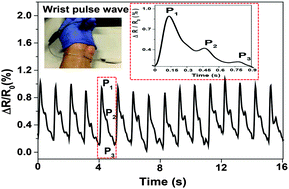Volume-invariant ionic liquid microbands as highly durable wearable biomedical sensors†
Abstract
Most current wearable electronic products are often based on rigid circuit board technologies, limiting their ‘true wearability’ on the soft human body due to the mechanical mismatch between electronic and biological materials. ‘True wearability’, which means intimate contact with the soft human body, can only really be achieved by stretchable electronics that can mimic the mechanical features of the human skin. The use of nanomaterials or wavy metal/semiconductor materials represents a promising strategy to achieve stretchable electronic devices, but such devices often experience local material delamination or cracking. In this work, we describe an ionic liquid (IL)-based approach for the fabrication of rubber band-like, stretchable strain sensors, which can circumvent these limitations. Non-volatile and flow properties allow us simply to ‘fill and seal’ microchannels fabricated by 3D printing to obtain lightweight, waterproof and thermally sensitive wearable sensors. Despite the simplicity of their fabrication, the sensors show excellent performance, including tunable sensitivity, detection of a wide range of strains (0.1–500%), high durability (little change in signal-to-noise ratios after 6 month storage under ambient conditions), an excellent long-term stability of 50 000 life cycles under both low (5%) and high (100%) strains. We further show that our IL-based sensor can accurately identify wrist pulses, and can be woven with commercial rubber bands into colourful bracelets for hand gesture detection, and seamlessly interface with wireless circuitry to allow the detection of cervical movements.

- This article is part of the themed collection: Materials Horizons 10th anniversary regional spotlight collection: Asia-Pacific

 Please wait while we load your content...
Please wait while we load your content...